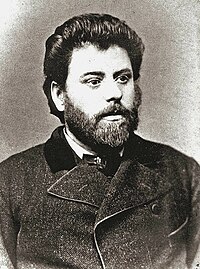Ion Creangă
| Ion Creangă Nică al lui Ștefan a Petrei Ion Torcălău Ioan Ștefănescu |
|
|---|---|
 |
|
| Born | 1837 or 1839 Târgu Neamț |
| Died | December 31, 1889 Iași |
| Pen name | Popa Smântână, Ioan Vântură-Țară |
| Occupation | Short story writer, educator, folklorist, poet, textile worker, cleric, politician |
| Nationality | Moldavian, Romanian |
| Period | 1864–1881 |
| Genre | anecdote, children's literature, erotic literature, fable, fairy tale, fantasy, lyric poetry, memoir, novella, satire, short story, sketch story |
| Literary movement | Realism, Junimea |
|
|
|
| Signature |  |
Ion Creangă (Romanian pronunciation: [iˈon ˈkre̯aŋɡə]; also known as Nică al lui Ștefan a Petrei, Ion Torcălău and Ioan Ștefănescu; March 1, 1837 – December 31, 1889) was a Moldavian, later Romanian writer, raconteur and schoolteacher. A main figure in 19th century Romanian literature, he is best known for his Childhood Memories volume, his novellas and short stories, and his many anecdotes. Creangă's main contribution to fantasy and children's literature includes narratives structured around eponymous protagonists ("Harap Alb", "Ivan Turbincă", "Dănilă Prepeleac", "Stan Pățitul"), as well as fairy tales indebted to conventional forms ("The Story of the Pig", "The Goat and Her Three Kids", "The Mother with Three Daughters-in-Law", "The Old Man's Daughter and the Old Woman's Daughter"). Widely seen as masterpieces of the Romanian language and local humor, his writings occupy the middle ground between a collection of folkloric sources and an original contribution to a literary realism of rural inspiration. They are accompanied by a set of contributions to erotic literature, collectively known as his "corrosives".
...
Wikipedia
